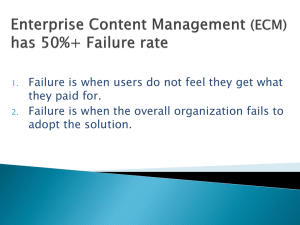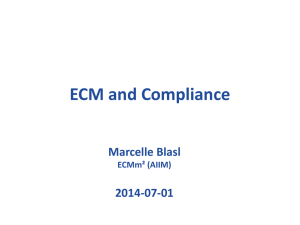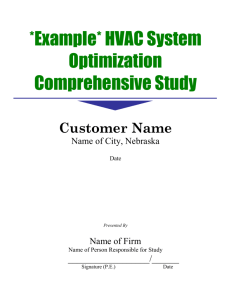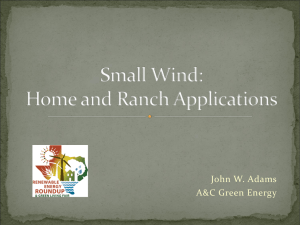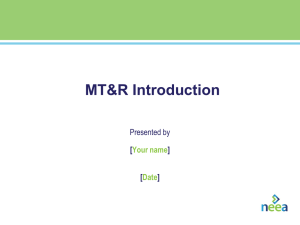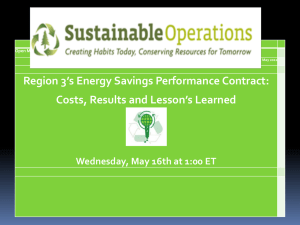Optimization of Net Zero Energy Houses Presentation
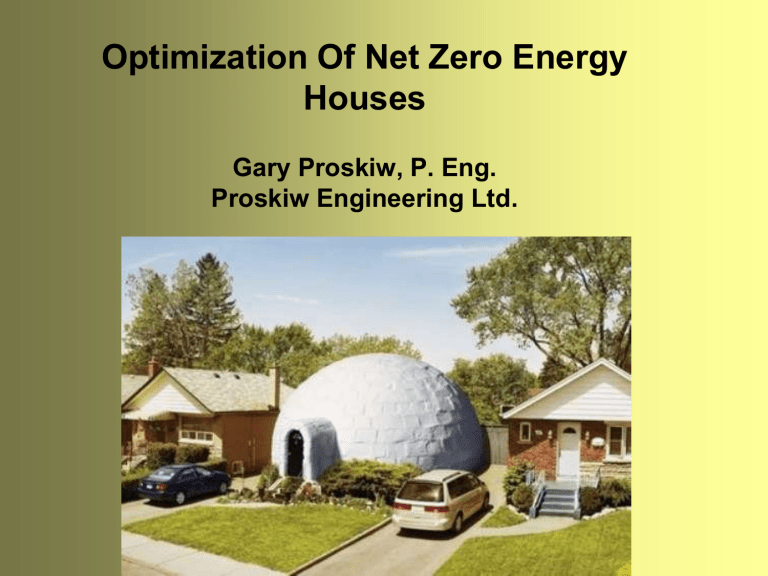
Optimization Of Net Zero Energy
Houses
Gary Proskiw, P. Eng.
Proskiw Engineering Ltd.
Why Optimization Is Important
• NZEH houses must meet a quantitative energy target (based on house size, climate and fuel type)
• As such, meeting the target is independent of most of the usual economic factors (interest rates, energy escalation rates, amortization periods, etc., etc.)
• We are not concerned about justifying the target, we are only concerned with how to reach it at the lowest possible cost
• This is exactly the same situation which exists for R-2000 and any other quantitative energy target-based code or standard
Current State Of The Art In Net Zero Energy
House Design
1. Minimize envelope heat loss by using a simple architectural labor, massive amounts of insulation and a high degree of airtightness.
2. Select the most efficient types of space heating, water heating and ventilation systems.
3. Use energy efficient lighting and appliances.
4. Maximize passive solar gains (while still respecting the 6% rule).
5. Use renewable energy systems to provide the balance of the energy requirements.
However…
● These are largely qualitative guidelines with little quantitative detail.
● What are “ massive ” amounts of insulation, what is a “ high degree of airtightness ”???
Objective Of The Study
1. To develop optimization guidelines for the design of
NZEH houses based on the energy performance of various conservation options, their attendant costs and the costs of renewable energy alternatives.
*
Since almost any house can theoretically achieve near-
NZEH status provided the occupants are prepared to forgo the comfort, health and safety benefits of modern housing, an implicit caveat was that the occupants should not have to live “cold, dark and unwashed”.
To Illustrate…
Consider The Envelope Design
For A Typical NZEH
● Ceiling: R-60
Walls: R-54
Basement walls: R-45
Basement floor: R-20
Window ER: 36 (picture), 26 (operators)
● Airtightness: 0.75 ac/hr
50
(new houses 1 – 3 ac/hr
50
, old houses 2 – 10 ac/hr
50
)
Estimated Incremental Cost
To Achieve NZEH Performance
Building envelope measures $26,200 (16%)
Mechanical system measures $9,700 ( 6%)
PV System $130,000 (78%)
Total Incremental Cost $165,900
But This Raises Some Obvious Questions…
Since the PV system was so expensive (78%)…
• Should we have used more insulation?
• Could we have used a more efficient mechanical system?
• Would a larger thermal solar system have made sense?
• In other words…Was the design optimized from a cost perspective?
????
Which Leads Us To…
Observation #1 – Designing a Net Zero Energy House is easy.
Observation #2 – The challenge is designing a NZEH house to achieve its energy goal without spending excessive amounts of money.
Performance Metric #1
ECM Value Index
= (Incremental cost of the ECM)
(annual energy savings)
= $ / (kWh/yr)
● In other words, it is the cost of installing an ECM which will save 1.0 kWh per year.
ECM Value Index
Select values (Winnipeg, medium-sized house):
0.35 - Upgrade airtightness from 1.50 to 1.00 ac/hr
50
0.60 - Reduce base loads from 24 to 18 kWh/day
2.46 - Upgrade walls from RSI 7.57 to 8.81 (R-43 to R-50)
5.12 - Increase thermal mass
14.3 - Increase south-facing glazing area from 6% to 7%
18.3 - Upgrade basement slab from U/I to RSI 1.76 (R-10)
Performance Metric #2
PV Value Index
= (PV System Cost) / (annual energy production)
= ($/W) / (kWh/yr •W)
= $ / (kWh/yr)
● Substitute the current (2008) PV System Cost ($9/W) and performance (1100 Wh/yr per W) to get the cost to generate
1.0 kWh per year…
= [(9 $/W) / (1100 Wh/yr•W)]
= $8 per kWh/yr
● In other words, the cost of installing a PV system capable of producing 1.0 kWh/yr would average about $8.
Using The ECM And PV Value Indices
● Notice that the PV and ECM Value Indices have the same units ($/(kWh/yr)) and can be compared directly to each other.
● Both define the investment required to save1.0 kWh/yr, whether through conservation or photovoltaics
(renewables).
● This gives us a tool to determine when further investments in conservation should be abandoned and re-directed to photovoltaics (or other renewables).
For Example, consider a couple of
Typical ECM’s (Winnipeg, medium-sized house)...
a) Walls: Upgrade from R-20 to R-27.5
Cost: $2924
Savings: 2661 kWh e
/yr
ECM Value Index: 1.1 b) Basement slab: Upgrade from U/I to R-10 (full slab)
Cost: $2805
Savings: 486
ECM Value Index: 5.8
Conclusion: The wall ECM is much more economic
than the slab upgrade.
When all the ECMs for one house/location/fuel source are plotted...
Prairie Climate
Medium-Sized House, Electric Heating
PV Value Index (2010)
5
4
7
6
3
2
1
0
Bad
Good
And then, reorganized...
Bad
Prairie Climate
Medium-Sized House, Electric Heating
7
6
5
4
3
2
1
0
SFG A/T Walls Attics Bsmt. W Slab Space DHW Vent. Base Loads
Good
Or, the climate (location) is changed...
Bad
Maritime Climate
Medium-Sized House, Electric Heating
7
4
3
2
1
6
5
0
SFG A/T Walls Attics Bsmt. W Slab Space DHW Vent. Base Loads
Good
Advantages Of Using
The ECM And PV Value Indices Approach
• Both have equivalent environmental advantages and disadvantages.
• No knowledge is required of future conditions such as:
– Interest rates
– Amortization periods
– Energy escalation rates, etc
What Was Done For The Optimization Analysis…
● Three archetype houses were created ranging in size from 112 m 2
(1200 ft 2 ) to 279 m 2 (3000 ft 2 ). All were conventional, merchant-built designs, but upgraded to “typical” NZEH standards.
● Insulation & airtightness levels were typical of levels found in NZEH houses in Canada.
● Each was modeled in four climate zones:
- Maritime (Vancouver, 2925 Celsius Heating DD)
- Prairie (Winnipeg, 5900 DD)
- Eastern (Toronto, 3650 DD)
- Northern (Yellowknife, 8500 DD)
What Was Done (con’t)…
● A list of approx. 50 ECM’s was assembled and their costs estimated.
● Each ECM was then modeled for each house/location combination.
● The Value Index was then calculated for each of the 12 house/location combination.
● Finally, the ECM Value Index was compared to the PV
Value Index ($8/kWh/yr) to determine the costeffectiveness of each ECM relative to the photovoltaic option.
Design Guidelines For
Net Zero Energy Houses
• Using this process, design guidelines were established for each of the 12 house/location combinations.
• The guidelines can be used by designers to create a first draft of the energy-related, design features of the house.
• Once these have been identified, the actual, proposed house design can be modeled and the design fine-tuned.
• The Value Index data can be modified to reflect local costs.
Example – Winnipeg, Medium-Sized House
Guidelines:
Thermal mass – light or medium weight framing, or heavy masonry.
Airtightness – 0.50 ac/hr
50
, or as tight as possible.
Walls – RSI 10.57 (R-60)
Attic – RSI 14.09 (R-80)
Basement walls – RSI 4.23 (R-24)
Basement slab – RSI 1.76 (R-10), perimeter only
Heating – Electric or GSHP, COP=3.0
DHW – Conservation package, GWHR, thermal solar
Ventilation – High efficiency HRV
Base loads – 40% of R-2000 defaults (i.e. 9.6 kWh/day)

